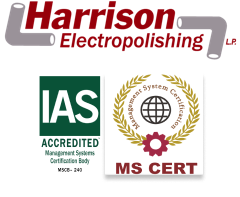FAQs
Our capabilities allow us to process components of all sizes. While most process equipment may fit within our electropolishing tanks, we have developed proprietary techniques in order to electropolish larger components. These proprietary techniques allow us to process equipment of any size at our facility or in the field.
The electropolishing process may improve a surface finish by up to 50%. The electropolishing reaction removes material while it improves surface roughness. Because of the material removal, process runtimes are often limited to maintain dimensional tolerances. Limited runtimes result in real world surface roughness improvements from 10 to 35%. Remember, electropolishing improves a surface on the microscopic level. If a material has a texture or surface scratch, electropolishing will only result in a lustrous texture or lustrous scratch. Mechanical polishing is utilized to remove macroscopic texture or blemishes.
Electropolishing is a surface treatment, not a surface coating. Thus, an electropolished surface can be physically damaged or degraded in the same way as its base material can be damaged or degraded. An electropolished 316 stainless steel surface has the same strength and hardness properties as those published for 316 material. Note however, because electropolishing may produce such a lustrous finish, even the finest surface scratch may be visible. Electropolished surfaces possess increased corrosion resistance and thus are more resilient in many corrosive environments.
Electropolishing is an electrochemical process while mechanical polishing is a mechanical process. Electropolishing is a surface treatment that can improve surface finish as it dissolves material from the surface. Mechanical polishing, like machining, alters a surface by cutting material away from the surface. Electropolishing can improve a surface finish on a microscopic level while mechanical polishing can improve a surface finish on a macroscopic level.
#4 finish is one of the many generally accepted, mechanical finishes which are often used in the metal finishing industry. Both the NiDi No. 9012 and previous revisions of ASME BPE specifications include a list that describes various mechanical surface finishes for stainless steel. A few common finishes include:
#4 - A widely used, general purpose finish produced by finishing with a 120-150 mesh abrasive. This finish is commonly found on architectural panels and stainless steel kitchen appliances and sinks.
#2B - A bright, cold-rolled finish. This finish is a standard finish for raw sheet metal and is produced at the mill.
#8 - A highly polished, highly reflective, "mirror like" surface . This finish is produced by polishing with successively finer abrasives followed with extensive buffing.
Simply put, Ra is the average of a set of individual measurements of a surfaces peaks and valleys. Learn more about Ra and the formulas used to calculate it.
RMS is the root mean square average of the profile height deviations from the mean line, recorded within the evaluation length. Learn more about RMS and the formulas used to calculate it.
Explore the differences on our Surface Finishes Page
Electropolishing removes material while electroplating adds material. Electropolishing and electroplating have similar setups, but they involve opposite reactions. Both are electrochemical reactions, however, in electropolishing the work-piece is charged anodically (thus loses ions) and in electroplating the work-piece is charged cathodically (gains ions).
The amount of material that is removed by electropolishing is directly proportional to the runtime and the amp-minutes that pass through the piece. Given this, the amount of material removed by electropolishing may be controlled. Often, during a standard run, material removal is only to 0.0003" to 0.0007". If the goal of an electropolishing run requires a longer runtime, as much as 0.003" of material may be removed. It is always important to review the dimensional tolerances of a component before it is electropolished.
Older drawings may use roughness grade numbers to indicate Ra values. The following table is given in ISO 1302:1992.
|
Roughness values Ra |
Roughness values Ra |
Roughness |
|
50 |
2000 |
N12 |
|
25 |
1000 |
N11 |
|
12.5 |
500 |
N10 |
|
6.3 |
250 |
N9 |
|
3.2 |
125 |
N8 |
|
1.6 |
63 |
N7 |
|
0.8 |
32 |
N6 |
|
0.4 |
16 |
N5 |
|
0.2 |
8 |
N4 |
|
0.1 |
4 |
N3 |
|
0.05 |
2 |
N2 |
|
0.025 |
1 |
N1 |

